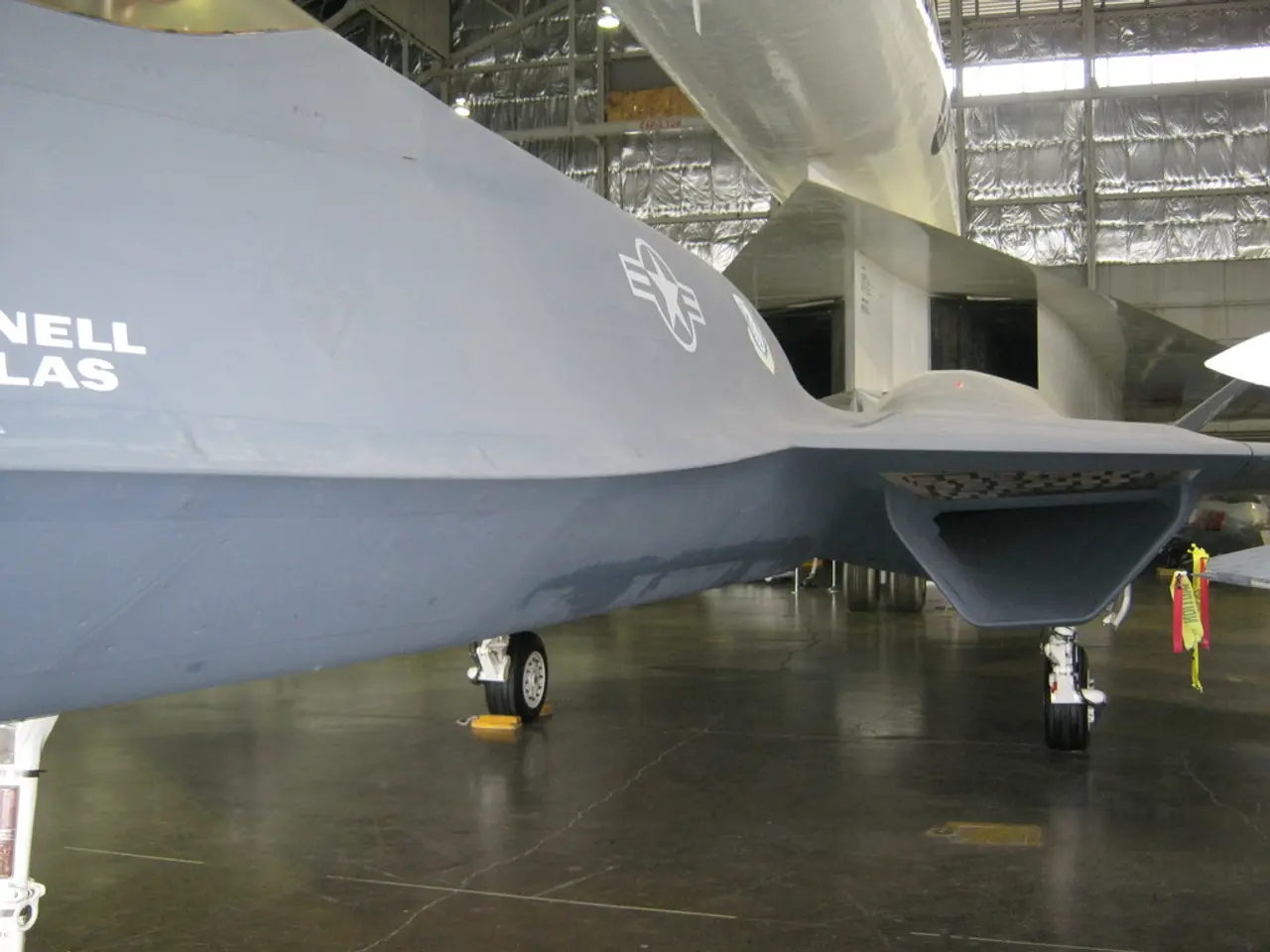A Comprehensive Examination of Regional Airline and Cargo Services Offerings in 2025
In the dynamic world of aviation, regional airlines and air freight services continue to evolve, adapting to the changing landscape of travel and commerce. This year, more than half of regional airlines have added new destinations, while Europe's air freight market has seen a notable 2.5% increase in volume.
Leading the charge among regional airlines in 2025 are JSX, Breeze Airways, Avelo Airlines, and Sun Country Airlines. Each airline showcases varied performance across on-time metrics, fleet expansion, route development, and sustainability.
JSX, the Travel + Leisure World's Best Regional Airline in North America for two consecutive years, stands out for its high customer satisfaction (92.29/100). The airline plans to expand its fleet options with turboprop services, enhancing its niche of private-jet-like experiences from private terminals (FBOs). This strategy, coupled with reduced airport congestion, likely aids timely operations and contributes to JSX's strong operational performance.
Breeze Airways leverages a premium low-cost model with fuel-efficient Airbus A220s, driving rapid route expansion and offering fares 44% lower than legacy carriers. This growth strategy, focusing on digital innovation and secondary airports, supports both fleet and route expansion while reducing operational costs. Breeze's model also implies improved sustainability through modern, fuel-efficient aircraft.
Avelo Airlines faces challenges in balancing capacity and revenue, with a 28% fare drop and a load factor only recently improving to 72%. Its aggressive capacity increase (18.4%) has strained financials and operational efficiency, reflecting risk in on-time performance and profitability. However, Avelo continues to expand routes in leisure markets.
Sun Country Airlines remains strong in regional leisure markets around its Minneapolis hub, with solid revenue on key routes. While specific data on on-time performance and fleet is limited, its stable market position suggests competent operational reliability.
In terms of on-time performance, JSX's private terminal operations and smaller airport usage help maintain high punctuality. Breeze and Sun Country benefit from operating largely out of secondary airports, which typically reduces delays. Avelo's rapid capacity increases have likely added operational strain, possibly impacting punctuality negatively.
Regarding fleet expansion, JSX plans turboprop additions to complement its existing fleet, Breeze continues adding fuel-efficient A220 jets, and Avelo grows capacity aggressively despite financial strain. Sun Country sustains its existing regional fleet for leisure routes.
Route expansion focuses on leisure and secondary markets, with Breeze and Avelo aggressively adding routes at smaller airports to reduce costs. Sun Country dominates routes tied to Minneapolis, and JSX capitalizes on private terminals for niche business travelers.
Sustainability initiatives are best reflected in Breeze’s use of fuel-efficient A220 aircraft and emphasis on digital tools to reduce costs and emissions, aligning with broader industry trends toward greener regional aviation. JSX’s use of smaller, less congested airports and private terminals may also contribute to lower emissions per flight cycle, though explicit programs are not detailed.
Meanwhile, in the air freight sector, regular maintenance checks on aircraft and equipment are essential to prevent mechanical failures. Data-driven decision-making is becoming standard practice for optimizing routes and schedules, resulting in fuel savings of approximately 15% and improving delivery timelines. Predictive analytics is becoming vital for inventory management, reducing excess storage costs by up to 35% and ensuring optimal stock levels.
Incorporating advanced technologies like AI and blockchain can streamline operations. Automation in inventory management and real-time tracking systems improves efficiency and enhances customer satisfaction. Establishing a transparent incident reporting system is crucial for maintaining high safety standards in cargo handling.
In the Middle East, cargo services are expanding, driven by strong trade links with Asia and Europe. Emirates SkyCargo reported an increase in cargo volumes by 5% in 2025. Companies that leverage these relationships report an average increase of 10% in on-time deliveries, a critical metric in cargo services.
The average fare for regional flights has risen by approximately 8% this year. 60% of regional fleets have initiated initiatives to reduce carbon emissions by at least 20% over the next five years. Geopolitical events also play a significant role. Trade tensions impact routes and service availability. Adjusting to these challenges by exploring alternative routes or partnerships may prevent disruptions.
Promoting direct routes to key destinations, such as flights to Germany cheap, can enhance market reach. Incorporating security plans that comply with local laws and international guidelines is essential for cargo services. Incident reporting can lead to a significant reduction in accident rates, with operators with strong Safety Management Systems (SMS) demonstrating up to a 50% decrease in reportable incidents.
Utilizing augmented reality (AR) for training staff can enhance efficiency, facilitating quicker onboarding and skill development. China leads with over 18 million tonnes transported in 2025, reflecting a strong rebound in manufacturing and exports. Building service networks in these areas may open new revenue streams for smaller operators.
Operational costs for regional airlines are a critical concern, with fuel and maintenance representing approximately 30% and 15% of total expenses, respectively. Adapting to regulatory changes proactively ensures compliance and mitigates risks associated with international shipping. Partnerships can reduce costs by up to 15% due to shared resources, optimized routing, and combined management systems.
Frankfurt and Amsterdam remain key transit points, with advancements in digital logistics further enhancing efficiency. Perishables and pharmaceuticals have seen the highest demand, with a 10% rise in temperature-controlled shipments. Smart temperature-controlled storage solutions utilize IoT sensors to monitor conditions in real-time, improving compliance with strict food and pharmaceutical transport regulations.
Investment in these cutting-edge solutions is vital for maintaining competitive advantage, with nearly 70% of logistics firms planning to enhance their technology stack in the coming years. 86% of U.S. domestic flights were conducted by smaller carriers in 2025. Piedmont Airlines Freight has reported a 15% increase in cargo volume from 2025 to 2025.
Implementing automated sorting systems significantly boosts cargo processing time, reducing average handling duration by up to 40%. Utilizing dedicated freighter aircraft can enhance load capacities, offering a reliable transport option for businesses needing rapid movement of goods. In 2025, global air freight volumes reached approximately 60 million tonnes, a 3% increase compared to the previous year.
Regular certification renewals help maintain high safety standards in cargo handling. Providing shared capacity on flights can improve efficiency and reduce costs, making services more appealing to clients looking for affordability. North America follows closely, moving about 25% of global cargo, with major hubs like Chicago O'Hare and Memphis International handling significant traffic.
Robotics in warehousing is streamlining operations, decreasing labor costs by 20% while increasing throughput, allowing facilities to handle 25% more volume during peak periods. The cargo sector is experiencing a reported rise in air freight of 14% year-on-year through Q3 2025.
Investment in cold chain logistics has become a priority for players in the sector. Regular safety audits and safety performance monitoring are crucial for ensuring compliance with safety policies. Emerging markets show potential for cargo expansion. Regions like Southeast Asia are expected to experience an annual growth rate of over 7% in air freight traffic.
All personnel involved in cargo handling must receive proper training, including understanding hazardous materials handling and emergency response protocols. 78% of passengers prefer services offering flexible ticketing options. Transitioning to sustainable fuels and reducing carbon footprints not only meets regulatory demands but also attracts environmentally conscious customers.
Drones can complete deliveries within one hour in urban areas, attracting investments that increased by 25% in the last year. Background checks on personnel and secure all cargo handling areas to prevent unauthorized access are necessary for cargo services. Investing in sustainability is becoming increasingly important. By 2025, it is projected that over 50% of companies will prioritize eco-friendly practices.
Asia-Pacific continues to dominate the air freight market, accounting for nearly 35% of total cargo volume. Analyzing incidents and near misses to educate and train staff reduces the risk of recurrence. The United States recorded a substantial 4% year-on-year growth in air freight, with e-commerce contributing significantly to this trend.
- The regional airlines JSX, Breeze Airways, Avelo Airlines, and Sun Country Airlines have made significant strides in diverse areas such as customer satisfaction, route development, fleet expansion, and sustainability in 2025.
- Breeze Airways, with its use of fuel-efficient Airbus A220 aircraft and emphasis on digital innovation, is leading the charge in the air freight sector's push towards greener operations, aligning with broader industry trends.
- Investment in advanced technologies like AI and blockchain, such as automation in inventory management and real-time tracking systems, plays a crucial role in streamlining cargo operations, improving efficiency, and enhancing customer satisfaction.




